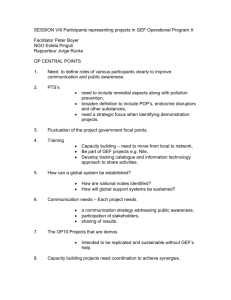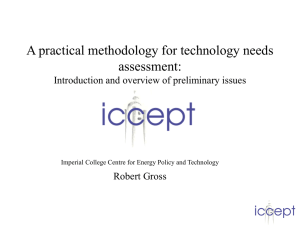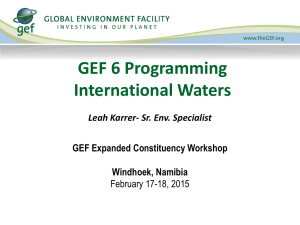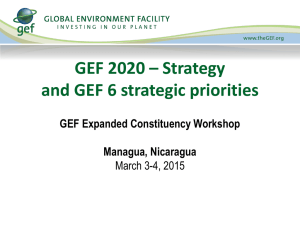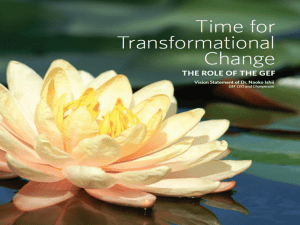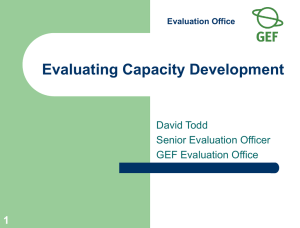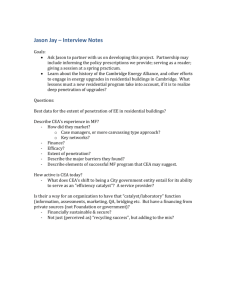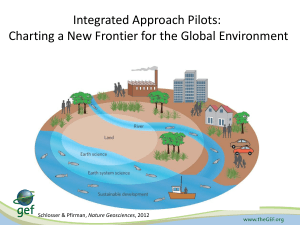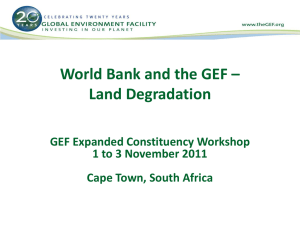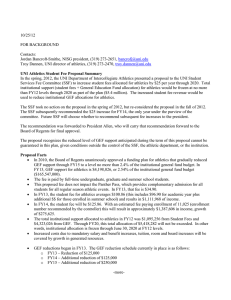The World Bank's experience with Country Environmental Analysis
advertisement
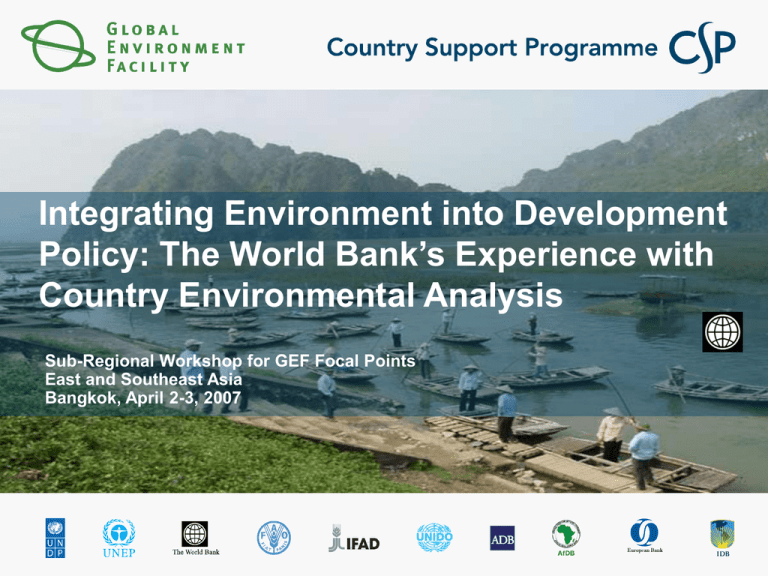
Integrating Environment into Development Policy: The World Bank’s Experience with Country Environmental Analysis Sub-Regional Workshop for GEF Focal Points East and Southeast Asia Bangkok, April 2-3, 2007 Outline Background: Trend towards diagnostic analyses Bank supported environmental analytical work in East Asia Country Environmental Analysis: An integrative environmental tool Links with other tools and processes Steps/Building Blocks Examples of CEA Background Development community and Bank CDF emphasize: • country ownership, • partnerships, • focus on development outcomes, • good policy based on sound analysis Need for broader environmental analysis is a part of this vision Various diagnostic tools already in use, eg. Poverty and gender assessments Tool required to integrate environmental concerns into country programming Bank Supported Analytical Work on the Environment in East Asia Environment Monitors Studies on poverty-environment nexus for PRS: Cambodia, Mongolia, Vietnam Health impacts and economic costs of pollution helped policy makers set priorities: China Studies of CZM and fisheries management in Viet Nam; land management policy reform in Indonesia, Cambodia, China, Mongolia, Philippines Strategic Environmental Assessment (SEA) – sector focused – env. impacts Country Environmental Analysis (CEA): An integrative environmental tool CEA: systematic, country-level diagnostic environmental analysis Objectives: • Integrate environmental considerations (including global) into country-level development assistance strategies and programs • Open avenues for upstream discussion of key cross-sectoral policy issues behind a country’s environmental challenges • Guide capacity building and institutional reform efforts Links with Other Tools and Processes Draws on: • work on sustainability and environmental indicators • Country led analyses: NEAP, Strategic Environmental Reviews, National Strategies for Sustainable Development • Work undertaken by development partners Could be underpinning for GEF RAF prioritization Key Steps/Building Blocks State of the environment and priorities for development Policy analysis Institutional capacity assessment Scope: detailed or rapid $50,000 to $200,000 Collaboration with country and development partners Examples of CEA 10 completed world wide; 10 on going incl. Vietnam; Indonesia and Timor-Leste planned Policy recommendations and identified WB and GEF follow up programs • Belarus • Egypt Integrated environment into PRSP and CAS and identified WB and GEF follow up investments • Serbia and Montenegro Led to institutional change • Tunisia decision to establish Ministry of Environment and Sustainable Development Belarus CEA Objective: To engage government and local stakeholders in dialogue on links between environmental management and underlying policy framework Content: • Critical review of situation in water, energy, solid waste and NRM • Poverty dimensions of these areas • Macroeconomic linkages and long term sustainability Recommended: policy actions in support of more environmental sustainability, and investments in above sub-sectors including GEF co-financing Egypt CEA Objectives: • Think piece to help government address MDG7: new tools for mainstreaming environment focusing on 4 priority issues Included specific GEF Recommendations: • reducing methane in SWM • Protect pristine areas of the Red Sea from degradation enhancing coastal areas • GEF financing incentives for greater private sector involvement in sustainable development • Combating desertification and land degradation to improve water quality Serbia and Montenegro CEA Objectives • Review the existing situation, identify priority areas for policy changes and consider roles of government, private sector and donors • Assess macroeconomic-environmental linkages • Provide basis for defining the Bank’s long term involvement in the environment sector Main Trends Identified Deteriorating trends in water, sanitation and waste management Threat of coastal zone deterioration in Montenegro Air pollution hotspots High energy efficiency Excessive industrial pollution Weak environmental management system Transboundary water and global environment issues Lack of sustainable forest management Recommendations and Outcomes Policy measures • Energy subsidies reduced • Water agencies agree on water charges Identified key sectors for investment in short and medium term donor support to build environment management capacity Biodiversity strategy developed Environment mainstreamed in CAS Bank and GEF operations Conclusions Built knowledge base on environmental issues and priorities Established dialogue with various government agencies during study Clarify Bank’s comparative advantage in meeting the priorities Establish donor coordination; and Mainstream environment in sector operation thanks to integrated approach GEF’S CHALLENGE Further Information http://www.worldbank.org/ Search for CEA
